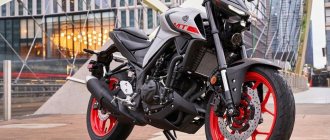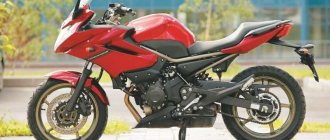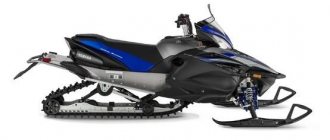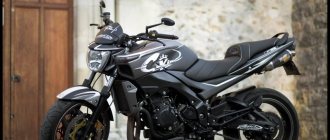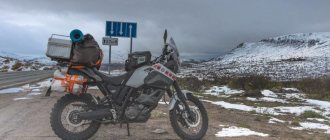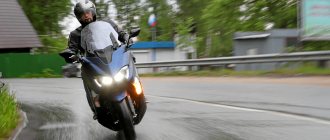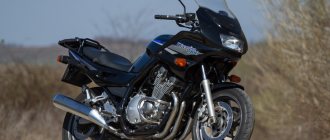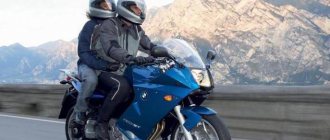All-terrain vehicle “Viking” - description of the model Strengths and weaknesses of the Viking 700 Technical equipment of the all-terrain vehicle Which “Viking” to buy
The line of “Vikings” - all-terrain vehicles from Yamaha - was released in 2014, replacing the Rhino model. The Yamaha Viking all-terrain vehicle received a new chassis. The main difference from its predecessor is the location of the motor. In the new model, the engine is located at the rear of the structure under the loading platform. This approach made it easier to maintain the engine and increase passenger comfort.
All-terrain vehicle “Viking” - model description
The all-terrain vehicle is powered by an updated Yamaha C engine. This is a single-cylinder four-stroke engine with a displacement of 686 cm3. To prevent overheating of the mechanism, a coolant system is used. The new engine is a modernization of the old one; outwardly they are almost indistinguishable, but the filling is different. The main changes in the design of the new generation Yamaha C engine were in the combustion chamber and cylinder head. Japanese engineers relied on low and medium speeds, which will be most in demand during its operation. With the new heart, the “Viking” can reach speeds of up to 80 km/h, and the power reserve is enough to overcome off-road conditions of varying complexity. The electronic fuel injection system installed on the engine allows you to start the car even at an altitude of 3 km above sea level. The microcomputer automatically reacts to changes in height and adjusts internal mechanisms.
The machine uses an Ultramatic CVT transmission - a leader for all-terrain vehicles of the ATV and SxS classes. The transmission is equipped with a centrifugal clutch, with additional pulleys for the primary and secondary clutches. Due to the presence of such a clutch, it is possible to keep the belt under constant tension, which increases the ability of the all-terrain vehicle to pass obstacles.
Yamaha Viking 700 received a front differential locking function. With its help and practical skills, you can climb difficult climbs. The car has an independent suspension, designed for difficult off-road routes. But it can also be used for sporting purposes if desired. Hydraulic disc brakes provide reliable braking in all weather conditions.
For an additional fee, you can equip the Yamaha Viking EPS with power steering, a winch, and a plow.
The Viking cabin can accommodate 3 people at the same time. The designers managed to comfortably accommodate three adults. Thanks to the center seat, which is recessed back, passengers do not bump their shoulders against each other. Users note the convenient location of the pedals and instrument indicators. The central passenger's legs are separated from the driver's, which reduces the likelihood of mistakenly pressing the pedals to zero.
Test drive Yamaha Viking VI: Bolivar that can handle six
Less than a year has passed since the debut of the three-seater Yamaha Viking 700 all-terrain vehicle, when the Japanese introduced a new, extended version of this “side-by-side”, now designed for six people! Will this Bolivar withstand so many riders and how does this “bus” drive off-road? We found out this in the forests near Moscow during the first test drive of the device in Russia.
Having launched the world's first all-terrain vehicle of the Side-by-side type (with driver and passenger seats arranged like a car) 11 years ago and creating, in fact, a fashion for such devices, Yamaha has not done anything in this segment for the time being. nothing outstanding. All these years, the Japanese have been exploiting (albeit very successfully) the solutions they once found, and their only UTV (Utility Task Vehicle) class model was the good old Rhino.
Competitors, however, having realized how in demand equipment of this type could be, did not sit idly by. Americans and Canadians, for example, expanded the scope of the segment by introducing sports models for “daring” off-road driving or competitions. They also began to produce multi-seat UTVs designed for four or even five riders.
Yamaha has not yet responded to the first trend in any way: at least, it is not officially known whether the Japanese are developing their own sports UTV. But the fashion for multi-seat devices did not escape their attention. Last year's Viking 700, it turns out, was just the first sign. Following her, the second one, a six-seater, has now arrived.
At the first glance at the device in real life, the thought flashed: “Bus!” And when six of my colleagues and I, in full ATV gear, fit inside without any problems, this nickname stuck to the “sixth” “Viking” completely and irrevocably.
Yamaha, by the way, calls the Viking VI the world's first true six-seat UTV. Polaris probably has a different opinion on this matter, but in fairness, we note that most current multi-seat vehicles, as a rule, have “benches” installed, which can only theoretically provide “passport” capacity. While the Viking has three separate seats both front and rear, each of which is equipped with a three-point seat belt. The backs of the middle seats are tilted back: just a little, only five degrees, but this, as it turned out, is enough for three adults to sit without touching each other’s shoulders.
The rest of the interior is designed with the same attention to detail. The gearbox and handbrake levers are located on the front panel - the driver and middle passenger do not interfere with each other. The gearbox lever itself moves along a zigzag slot - you won’t miss the desired position. The puck for selecting all-wheel drive transmission modes looks unsightly, but it is very convenient to work with gloves: the forces are adjusted, the positions are clearly recorded.
And it was comfortable for me to sit behind the wheel, with my height of 193 cm: I didn’t even have to adjust the seat. Although the opportunity itself exists. True, to do this you will have to unscrew the bolts and move the chair from one fixed position to another. But I sat down “by myself” without any problems. Moreover, with such a reserve, which is sometimes not possible in other cars.
However, the main question that worried me and my colleagues who gathered at the first Russian test of the six-seater “Viking” was completely different: would this “bus” fail on serious off-road conditions? There were doubts: the base turned out to be too long. And the engine remains the same as in the three-seat version - isn’t it a bit weak for a vehicle designed for six?
These doubts were eventually dispelled only partially. The device as a whole has enough “geometry” and traction capabilities of the engine. But - at the limit.
For active driving on a broken country road, the Viking VI is even better suited than the three-seater “seven hundredth”: thanks to the long wheelbase, the “sixth” effect is less pronounced. While the “seven hundred” sometimes forces passengers to grab the handrails more tightly. And for this feeling of stability, the “six” can be forgiven a lot. Including the fact that when making your way through open forest, it is not always possible to follow the trail of the Viking 700. The trajectory has to be literally calculated, directing the front wheels to turn “like a bus”, along a wider radius.
If you need to cross a ditch diagonally (and the Viking 700 does this exercise with ease), you really need to act on the principle of “measure twice, cut once.” Otherwise you won’t be able to sit on the “belly”. Which, however, is not at all scary, since the bottom of the device is absolutely flat, protected by a steel sheet. Moreover, on the sides it is raised by 60 mm.
In general, those places where geometric cross-country ability plays a major role must be overcome at speed, with acceleration. Fortunately, the ground clearance of 290 mm and the ATV-like long-travel and energy-intensive suspension completely allow this.
The rider also has to be careful on steep sandy climbs. If there are no detours and you need to climb the mountain, then it is better to do it from acceleration. Otherwise, the traction capabilities of the engine may not be enough.
In all other cases - complete delight! The device confidently and powerfully carries six riders both along a track filled with muddy swamp slurry and through fords. Moreover, the Viking VI can overcome water obstacles even where the depth is as deep as the headlights: the air intake pipe is located at the base of the A-pillar. To “flood” the engine, you need to try hard...
So what's the bottom line? For whom was the new “Viking” created and who will be interested in it in Russia? Yamaha positions it as an off-road vehicle designed to solve a wide range of purely utilitarian tasks: from family outings far from civilization to fishing, hunting, patrolling in difficult terrain and agricultural work.
The pleasure of owning a new Viking VI is, of course, not cheap (the device will go on sale in the Russian Federation in November and will cost approximately 900,000 rubles).
However, purchasing an SUV and then specially preparing it to have comparable off-road capabilities will cost even more. Something to think about!
Or you can wait a little: as representatives of the Russian office of Yamaha told us, Japanese designers are already developing a more powerful (most likely 1000 cc) engine for the Viking VI and the future top version of the Grizzly ATV. A liter Viking will be a real bomb!..
Strengths and weaknesses of the Viking 700
The Yamaha Viking all-terrain vehicle turned out to be a balanced machine. The introduction of new engineering and design solutions has improved the overall quality of the car and its impression. What are the pros and cons of “Viking”?
The advantages of the all-terrain vehicle include:
- American made;
- reasonable cost;
- one-time transportation of 3 people;
- economical engine;
- smooth operation of the gearbox;
- volumetric tank.
The model is not without its drawbacks:
- engine vibration when idling;
- rigid suspension;
- You must stop to lock the front differential.
And it's comfortable!
The cabin of the model is much more spacious than that of the Rhino. There is enough space for three adults. The middle passenger occupies a bucket seat located slightly behind the others so that the person sitting in it does not push the driver and third passenger. In addition, the middle seat has special foot holders built into the floor to keep them away from the pedals. In addition, passengers can hold on to a large, adjustable handrail. Even I, being in the driver's seat, grabbed it several times when I had nowhere to put my long right arm. The fuel tank capacity is 37 liters, which is quite enough for long trips. The Yamaha engine has always been a fuel-efficient engine, and I was pleasantly surprised to learn how efficient it was in the Viking despite the increased size and weight of the vehicle. Even if you fully load it, it can go all day without refueling.
There's no doubt that the 2014 Yamaha Viking is a great replacement for the aging Rhino. It's bigger, more powerful and faster than any other Yamaha SxS available today. However, in the large ATV/UTV segment, Viking will have plenty of worthy competitors. Ultimately, this model should bring considerable profits to the Japanese manufacturer, but will it be able to increase the company's market share? Time will show.
pros
- US assembly
- very smooth variator
- reasonable price
- passenger capacity up to 3 people
- large fuel tank
- economical motor
Minuses
- vibrations of a single-cylinder engine at low speeds
- rigid sports suspension
- Locking the front differential requires a complete stop of the car
Technical equipment of an all-terrain vehicle
Let's talk about the technical side of the issue. Yamaha all-terrain vehicles traditionally have good technical characteristics. “Viking” continued the tradition. Here are the official data on the model:
| Description of the motor | single cylinder, 4-stroke, 4-valve, liquid cooled |
| Bore x stroke | 102.0 x 84.0 mm |
| Engine starting | EFI (electronic injection) |
| Engine displacement | 686 cm3 |
| Component lubrication system | wet sump |
| Starter type | electric starter |
| Ignition system | TCI |
| checkpoint | CVT Ultramatic |
| Drive unit | 2WD/4WD/4WD + front differential lock |
| Weight Limit | 272 kg |
| All-terrain vehicle length | 3100 mm |
| Width | 1570 mm |
| Height | 1882 mm |
| Wheelbase | 2135 mm |
| Volume of the tank | 44 l |
| Clearance | 300 mm |
